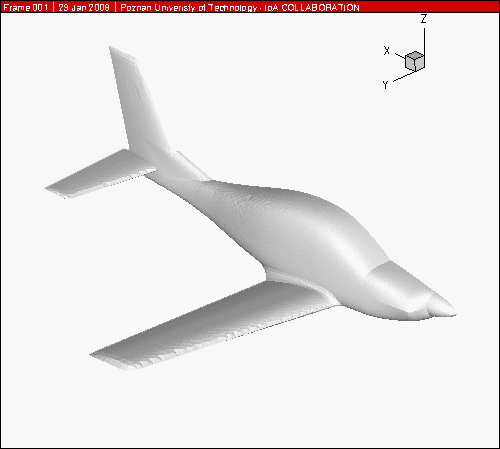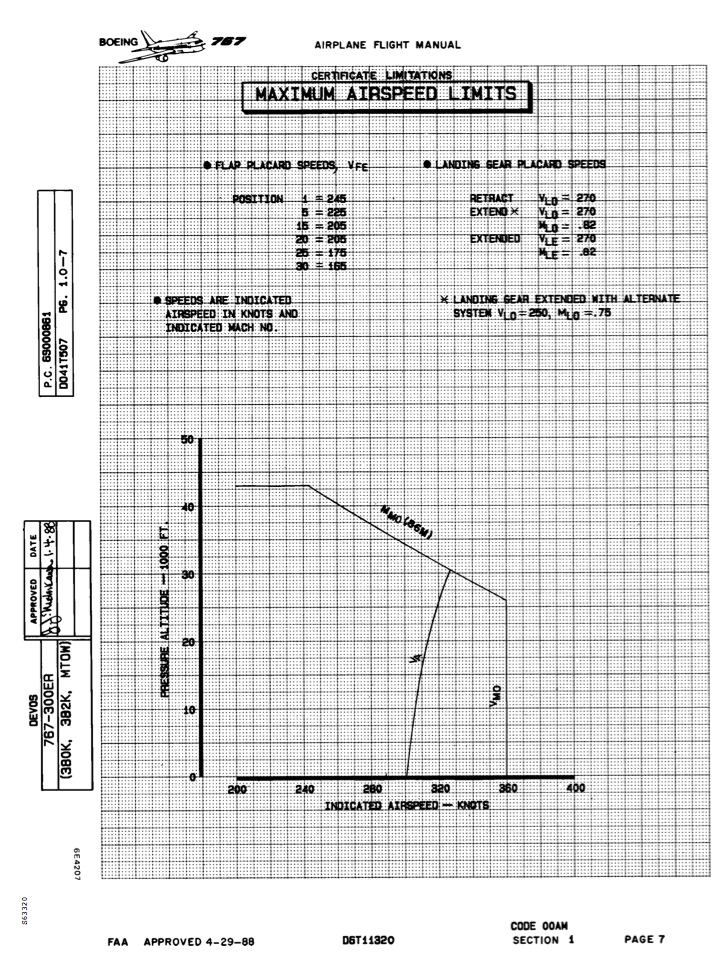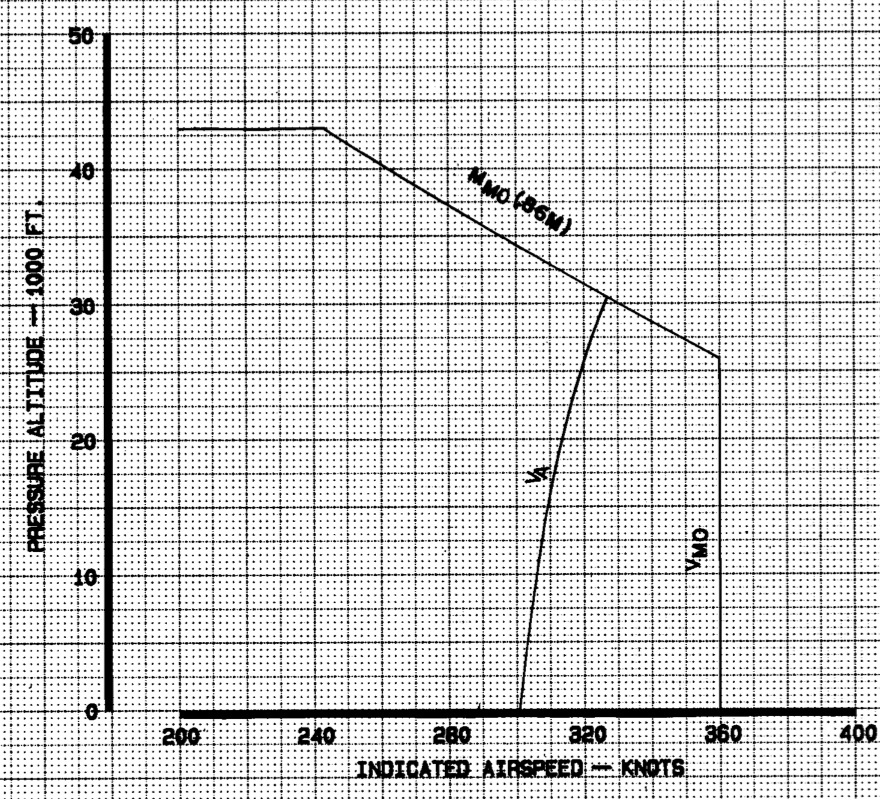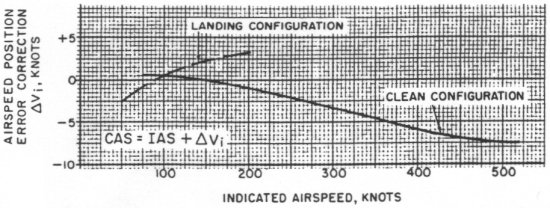A point sometimes raised in 9/11 discussion is that the the planes, and in particular UA175, were flying above their maximum "safe" speed, with the claim being made that they would immediately experience flutter, and hence be uncontrollable, and quickly break apart. The implication being that the planes that impacted the World Trade Center, the Pentagon, and the field at Shanksville, were not stock planes, but were planes that have been modified in some way, or were entirely different types of plane in disguise - possibly even not the same planes that took off that morning, but some other planes that were craftily swapped in at some point in the flight.
While this seems like an incredible, even ridiculous theory, it's raised often enough that it's worth looking in detail into how flutter occurs, and at what speed, so we can see if this is in any way relevant to the events of 9/11.
What is the Claim?
The specific claim made by Pilots for 9/11 Truth is:
(From "SkyGate 9/11")
[bunk]Vd is a hard limit, meaning there is no additional margin of safety above Vd[/bunk]
As we will see, this is incorrect, and there is a FAA certification margin of safety of 20% above the Vd limit.
What is Flutter?
Flutter is a resonance effect where, at certain speeds and conditions, oscillations of parts of the plane are amplified by the passing air, and grow in amplitude. This can lead to loss of control and damage to the plane. Severe flutter can rip the wings or stabilizers off a plane. Here's what it looks like in simulation:
http://stanton.ice.put.poznan.pl/flutter-laboratory/

What is Vd (and Vne)?
All planes have a set of "V-speeds" specified by the manufacturer, and certified by extensive testing and analysis. The V-speeds are either specific speeds that are optimal for a particular purpose (such as Vglide, the best speed for a power-off gliding descent) or are high or low limits beyond which a particular operation should not be attempted (such as Vlo - the maximum speed you can fly with landing gear lowered).
For this discussion the most relevant V speeds are Vne (V Never Exceed) and Vd (V Dive). Vne is the speed that that pilot should never take the plane beyond. Vd is the speed beyond which structural problems are predicted to start to occur (or have been observed to start to occur, in which case it is denoted Vdf). Vne is less than Vd (usually around 90% of Vd), so for purposes of this discussion, Vd is the maximum "safe" structural speed of the aircraft.
What is Vd and the observed impact speed for UA175?
The fastest 9/11 plane, UA175, was a 767-200. Vd for a 767-200 is 420 KCAS below 17,854 feet, according to FAA certification data. (420 Knots Calibrated Air Speed, or 420*1.15 = 483 mph).
At what speed would flutter become a problem?
Flutter is not something that simply happens at one particular speed. The onset and amplification of flutter depend upon a variety of factors, including the loading of the plane (in particular the fuel loading in the wings), and the turbulence of the atmosphere. Even then the flutter requires some initial oscillation (excitation) of the affected structure in order for it to start.
NASA has a very detailed document on the history of flutter testing, in which they discuss the problems of getting sufficient excitation to induce flutter. Solutions to this problem included flying around looking for areas of high turbulence, attaching small rockets to the wings, or having rotating weights inside the wings.
http://www.nasa-usa.de/centers/dryden/pdf/88390main_H-2077.pdf
At what speeds is Flutter NOT a problem?
If we can't tell at what exact speed flutter will occur, then perhaps we can find a speed below which it will not occur. We know it should not occur below Vd, but the CAR 4b.308, proposed in 1964, says:
http://lessonslearned.faa.gov/ElectraWings/4b.308.pdf
http://rgl.faa.gov/Regulatory_and_G...9DD00A6A3FBA4A088525667200503326?OpenDocument
http://rgl.faa.gov/Regulatory_and_G...1AF764F921FAD01C862568E900643105?OpenDocument
Vd for a 767-200 is 420 KCAS/483mph, so 1.2 Vd is 504 KCAS/580 mph.
http://en.wikipedia.org/wiki/United_Airlines_Flight_175
Some additional clarifications follow:
Does Vd vary with altitude?
Yes, however the Vd limit of 420 Knots is the Calibrated Airspeed (essentially the same as the indicated airspeed) , which is the same as the true airspeed at sea level. The FAA certification document says:
Source: http://www.scribd.com/doc/210896551/BOEING-767-Airplane-Flight-Manual

closer in for clarity:

Notice the Vmo is a constant indicated airspeed below 26,000 feet. This means that the Vmo of a 767 is 360 knots at sea level. The same applies to Vd, meaning Vd of a 767 is 420 knots at sea level.
MPH vs. Knots, KTAS, KIAS, KCAS, and KEAS
The multiple ways of indicating the speed of a plane area source of confusion here. Firstly there MPH vs. knots. We are all familiar with MPH, and knots is simply nautical miles per hours. A nautical mile is 1.15 standard miles. So 1 knot is 1.15 mph. So 420 Knots i 420*1.15 = 483 mph.
Now with all the K...AS units, these are speeds measured in knots, however they are AIR SPEEDS, i.e the speed of the plane relative to the air it is moving though. If you imagine a plane flying through calm air at 300 knots, then it's moving over the ground at 300 knots. The ground speed is the same as the air speed. However if the plane is flying at the same airspeed into a 50 knot headwind, then while the airspeed is still 300 knots, the ground speed will only be 250 knots.
The airspeed mentioned above is the "true" airspeed, KTAS (Knots True Air Speed). Unfortunately there is no simple way of measuring this from on the plane.
KIAS is the Indicated Airspeed. This is the speed that the airspeed indicator will show. This is roughly accurate at sea level, but at higher altitudes will show a lower number due to reduced air pressure.
KCAS is Calibrated Airspeed. This can be a little confusing, KIAS varies by plane, KCAS is essentially the KIAS for a hypothetical perfect airspeed indicator. So to convert KIAS to KCAS we are correcting for instrument error and variations in temperature. Here's an example conversion chart showing the corrections are fairly small.

For most practical purposes here KIAS and KCAS can be considered to be the same.
KEAS is the Equivalent Airspeed. Wikipedia describes it as "Equivalent airspeed (EAS) is the airspeed at sea level in the International Standard Atmosphere at which the dynamic pressure is the same as the dynamic pressure at the true airspeed (TAS) and altitude at which the aircraft is flying.[1][2] In low-speed flight, it is the speed which would be shown by an airspeed indicator with zero error.[3] It is useful for predicting aircraft handling, aerodynamic loads, stalling etc."
The important thing to remember in the context of this discussion (planes flying into buildings near sea level) is that all these values are essentially the same thing.
http://en.wikipedia.org/wiki/Knot_(unit)
http://en.wikipedia.org/wiki/Airspeed_indicator
While this seems like an incredible, even ridiculous theory, it's raised often enough that it's worth looking in detail into how flutter occurs, and at what speed, so we can see if this is in any way relevant to the events of 9/11.
What is the Claim?
The specific claim made by Pilots for 9/11 Truth is:
(From "SkyGate 9/11")
[bunk]Vd is a hard limit, meaning there is no additional margin of safety above Vd[/bunk]
As we will see, this is incorrect, and there is a FAA certification margin of safety of 20% above the Vd limit.
What is Flutter?
Flutter is a resonance effect where, at certain speeds and conditions, oscillations of parts of the plane are amplified by the passing air, and grow in amplitude. This can lead to loss of control and damage to the plane. Severe flutter can rip the wings or stabilizers off a plane. Here's what it looks like in simulation:
http://stanton.ice.put.poznan.pl/flutter-laboratory/

What is Vd (and Vne)?
All planes have a set of "V-speeds" specified by the manufacturer, and certified by extensive testing and analysis. The V-speeds are either specific speeds that are optimal for a particular purpose (such as Vglide, the best speed for a power-off gliding descent) or are high or low limits beyond which a particular operation should not be attempted (such as Vlo - the maximum speed you can fly with landing gear lowered).
For this discussion the most relevant V speeds are Vne (V Never Exceed) and Vd (V Dive). Vne is the speed that that pilot should never take the plane beyond. Vd is the speed beyond which structural problems are predicted to start to occur (or have been observed to start to occur, in which case it is denoted Vdf). Vne is less than Vd (usually around 90% of Vd), so for purposes of this discussion, Vd is the maximum "safe" structural speed of the aircraft.
What is Vd and the observed impact speed for UA175?
The fastest 9/11 plane, UA175, was a 767-200. Vd for a 767-200 is 420 KCAS below 17,854 feet, according to FAA certification data. (420 Knots Calibrated Air Speed, or 420*1.15 = 483 mph).
The estimates of speed for UA175 range from 503 mph (visual analysis) to 590 mph (radar analysis).
I - Model 767-200 (Approved July 30, 1982)
VD = 420 KCAS to 17,854 ft/.91M above 23,000 ft, linear variation between these points.
VFC = 390 KCAS to 17,600 ft/382 KCAS at 23,000 ft/.87M above 26,000 ft, linear variationbetween these points.
VMO = 360 KCAS/.86M
At what speed would flutter become a problem?
Flutter is not something that simply happens at one particular speed. The onset and amplification of flutter depend upon a variety of factors, including the loading of the plane (in particular the fuel loading in the wings), and the turbulence of the atmosphere. Even then the flutter requires some initial oscillation (excitation) of the affected structure in order for it to start.
NASA has a very detailed document on the history of flutter testing, in which they discuss the problems of getting sufficient excitation to induce flutter. Solutions to this problem included flying around looking for areas of high turbulence, attaching small rockets to the wings, or having rotating weights inside the wings.
http://www.nasa-usa.de/centers/dryden/pdf/88390main_H-2077.pdf
So the onset of flutter is determined by a combination of speed and excitation, not simply speed alone. However as speed increases, the ability of the plane to dampen any excitation decreases, so the amount of excitation required to induce flutter will decrease. However we can't say for sure that flutter will occur at a certain speed. Just that it is increasingly likely to occur as speed increases.
Structural excitation is a necessary part of the flight flutter
testing methodology. Detection of impending aeroelastic
instabilities cannot be made without adequate
excitation. Adequate excitation provides energy to excite
all of the selected vibration modes with sufficient magnitudes
to accurately assess stability from the response data.
The Transavia PL12/T-400 airplane (ref. 16) clearly
demonstrated the importance of adequate excitation levels
in 1986. This airplane was excited on the initial flight tests
by control surface pulses and random atmospheric turbulence.
Flutter did not occur during the flight test. In a subsequent
flight, the airplane experienced violent
oscillations of the rudder and tail boom when it was flown
in rough weather conditions. These weather conditions
provided higher levels of excitation than the levels
induced during the flight flutter test.
[...]
In the 1950’s, the United States learned that low excitation levels
tend to give a large scatter in the damping values estimated
from the response data. In addition, the estimated
values suggested lower aerodynamic damping than actually
existed. During flutter testing of the B-58 airplane
(ref. 17), it was found that a structural excitation level at
least three to four times higher than was obtained by random
atmospheric turbulence was necessary to provide an
acceptable level of excitation.
At what speeds is Flutter NOT a problem?
If we can't tell at what exact speed flutter will occur, then perhaps we can find a speed below which it will not occur. We know it should not occur below Vd, but the CAR 4b.308, proposed in 1964, says:
http://lessonslearned.faa.gov/ElectraWings/4b.308.pdf
And this was codified a FAR 25.629 in 1965:
§ 4b.308 Flutter, deformation. and vibration. Compliance with the following provisions
shall be shown by such calculations, resonance tests, or other tests as are found necessary
by the Administrator.
(a) Flutter prevention. The airplane shall be designed to be free from flutter of wing and
tail units, including all control and trim surfaces, and from divergence (i.e. unstable
structural distortion due to aerodynamic loading), at all speeds up to 1.2 VD. A smaller
margin above VD shall be acceptable if the characteristics of the airplane (including the
effects of compressibility) render a speed of 1.2 VD unlikely to be achieved, and if it is
shown that a proper margin of damping exists at speed VD. In the absence of more
accurate data, the terminal velocity in a dive of 30 degrees to the horizontal shall be
acceptable as the maximum speed likely to be achieved. If concentrated balance weights
are used on control surfaces, their effectiveness and strength, including supporting
structure, shall be substantiated.
(b) Loss of control due to structural deformation. The airplane shall be designed to be
free from control reversal and from undue loss of longitudinal, lateral, and directional
stability and control as a result of structural deformation, including that of the control
surface covering, at all speeds up to the speed prescribed in paragraph (a) of this section
for flutter prevention.
http://rgl.faa.gov/Regulatory_and_G...9DD00A6A3FBA4A088525667200503326?OpenDocument
And essentially the same applies in the regulations that applied from 1978 to 1992:(b) Flutter and divergence prevention. The dynamic evaluation of the airplane must include an investigation of the significant elastic, inertia, and aerodynamic forces associated with the rotations and displacements of the plane of the propeller. In addition the following apply:
(1) The airplane must be designed to be free from flutter and divergence (unstable structural distortion due to aerodynamic loading) at speeds up to 1.2 VD.
(2) A smaller margin above VD may be used if--
(i) The characteristics of the airplane (including the effects of compressibility) make a speed of 1.2 VD unlikely to be reached;
(ii) A proper margin of damping exists at VD; and
(iii) There is no large and rapid reduction in damping as VD is approached.
http://rgl.faa.gov/Regulatory_and_G...1AF764F921FAD01C862568E900643105?OpenDocument
How does this apply to UA175?b) Flutter and divergence prevention. The dynamic evaluation of the airplane must include an investigation of the significant elastic, inertia, and aerodynamic forces associated with the rotations and displacements of the plane of the propeller. In addition, the following apply:
(1) The airplane must be designed to be free from flutter and divergence (unstable structural distortion due to aerodynamic loading) for all combinations of altitude and speed encompassed by the VD/MD versus altitude envelope enlarged at all points by an increase of 20 percent in equivalent airspeed at both constant Mach number and constant altitude, except that Mach effects for Mach numbers greater than 1.0 need not be included when MD is less than 1.0 at all design altitudes and the following is established--
(i) A proper margin of damping exists at all speeds up to MD; and
(ii) There is no large and rapid reduction in damping as MD is approached.
Vd for a 767-200 is 420 KCAS/483mph, so 1.2 Vd is 504 KCAS/580 mph.
http://en.wikipedia.org/wiki/United_Airlines_Flight_175
So, based on the above, we can say that a 767 should not experience flutter (or any loss of control) below 580 mph. And given that flutter requires additional excitation, and some initiation time, and that the very highest estimate for speed for US175 was 590mph, then it seems unlikely that flutter would have caused significant problems for the pilots of UA175, who were intent solely on crashing the plane into a building.The United Airlines Flight 175 aircraft was a Boeing 767-222 that had been built in 1983, registration number N612UA
Some additional clarifications follow:
Does Vd vary with altitude?
Yes, however the Vd limit of 420 Knots is the Calibrated Airspeed (essentially the same as the indicated airspeed) , which is the same as the true airspeed at sea level. The FAA certification document says:
Note that Vd is a certification speed, not an actual operating limit, so it does not show up in the 767 flight manual. However the lower speed Vmo does:
VD = 420 KCAS to 17,854 ft/.91M above 23,000 ft, linear variation between these points.
VFC = 390 KCAS to 17,600 ft/382 KCAS at 23,000 ft/.87M above 26,000 ft, linear variation between these points.
VMO = 360 KCAS/.86M
Source: http://www.scribd.com/doc/210896551/BOEING-767-Airplane-Flight-Manual

closer in for clarity:

Notice the Vmo is a constant indicated airspeed below 26,000 feet. This means that the Vmo of a 767 is 360 knots at sea level. The same applies to Vd, meaning Vd of a 767 is 420 knots at sea level.
MPH vs. Knots, KTAS, KIAS, KCAS, and KEAS
The multiple ways of indicating the speed of a plane area source of confusion here. Firstly there MPH vs. knots. We are all familiar with MPH, and knots is simply nautical miles per hours. A nautical mile is 1.15 standard miles. So 1 knot is 1.15 mph. So 420 Knots i 420*1.15 = 483 mph.
Now with all the K...AS units, these are speeds measured in knots, however they are AIR SPEEDS, i.e the speed of the plane relative to the air it is moving though. If you imagine a plane flying through calm air at 300 knots, then it's moving over the ground at 300 knots. The ground speed is the same as the air speed. However if the plane is flying at the same airspeed into a 50 knot headwind, then while the airspeed is still 300 knots, the ground speed will only be 250 knots.
The airspeed mentioned above is the "true" airspeed, KTAS (Knots True Air Speed). Unfortunately there is no simple way of measuring this from on the plane.
KIAS is the Indicated Airspeed. This is the speed that the airspeed indicator will show. This is roughly accurate at sea level, but at higher altitudes will show a lower number due to reduced air pressure.
KCAS is Calibrated Airspeed. This can be a little confusing, KIAS varies by plane, KCAS is essentially the KIAS for a hypothetical perfect airspeed indicator. So to convert KIAS to KCAS we are correcting for instrument error and variations in temperature. Here's an example conversion chart showing the corrections are fairly small.

For most practical purposes here KIAS and KCAS can be considered to be the same.
KEAS is the Equivalent Airspeed. Wikipedia describes it as "Equivalent airspeed (EAS) is the airspeed at sea level in the International Standard Atmosphere at which the dynamic pressure is the same as the dynamic pressure at the true airspeed (TAS) and altitude at which the aircraft is flying.[1][2] In low-speed flight, it is the speed which would be shown by an airspeed indicator with zero error.[3] It is useful for predicting aircraft handling, aerodynamic loads, stalling etc."
The important thing to remember in the context of this discussion (planes flying into buildings near sea level) is that all these values are essentially the same thing.
http://en.wikipedia.org/wiki/Knot_(unit)
http://en.wikipedia.org/wiki/Airspeed_indicator
Attachments
Last edited:



